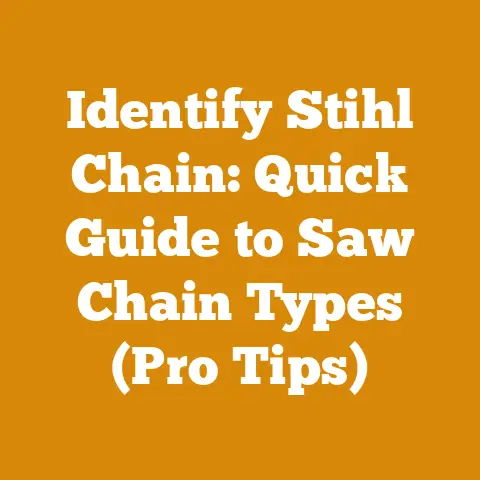How to Fix Tree Bark Damage on Young Apple Trees (Expert Woodcare Tips)
Imagine biting into a crisp, juicy apple straight from your own backyard – a taste of nature’s goodness that you nurtured from a sapling. That’s the dream, isn’t it? A mini-orchard, a sustainable source of deliciousness, a little slice of paradise right outside your door. But what happens when your young apple trees, the future bearers of those delectable fruits, suffer bark damage? It’s like a punch in the gut, a threat to your carefully cultivated dream. That’s where I come in. I’ve spent years immersed in the world of trees, from felling giants in the forest to coaxing life back into struggling saplings. And trust me, bark damage on young apple trees is a problem I’ve seen more times than I can count.
Understanding the Enemy: Causes of Bark Damage on Young Apple Trees
Before we dive into the “how-to,” it’s crucial to understand the “why.” Bark damage on young apple trees isn’t just a cosmetic issue; it’s a potential gateway for pests, diseases, and ultimately, the demise of your tree. Identifying the cause is the first step towards effective treatment. Here are some of the most common culprits:
Sunscald
Sunscald is a significant threat, particularly during winter months and in regions with drastic temperature fluctuations. The south and southwest sides of the tree are most vulnerable. Here’s how it happens:
- Winter Warmth: On sunny winter days, the bark heats up, prompting cells beneath the bark to become active.
- Sudden Freeze: When the sun sets or temperatures plummet suddenly, these active cells freeze and rupture, causing bark to split and die. This damage often becomes visible in spring as dead, sunken areas on the bark.
- Data Point: Studies show that young trees with thin bark are particularly susceptible to sunscald. A 2018 study by the University of Minnesota Extension found that trees with a trunk diameter of less than 4 inches were twice as likely to suffer sunscald damage compared to more mature trees.
Rodents
Rabbits and mice are notorious for gnawing on the bark of young trees, especially during winter when other food sources are scarce.
- Low to the Ground: Rodent damage is typically found near the base of the tree, often below the snow line.
- Girdling: In severe cases, rodents can completely girdle the tree, meaning they chew away a ring of bark all the way around the trunk. This cuts off the flow of nutrients and water, eventually killing the tree.
- Personal Story: I once lost an entire row of young apple trees to rabbit damage. The winter was particularly harsh, and the rabbits were relentless. I learned my lesson the hard way and now take preventative measures every fall (more on that later).
- Data Point: According to the U.S. Department of Agriculture, rodent damage can cause significant economic losses in fruit orchards, with some growers reporting losses of up to 20% of their young trees annually.
Deer
Deer can cause significant damage by rubbing their antlers against the trunks of young trees, especially during the fall rutting season.
- Antler Rubbing: Deer rub their antlers to remove velvet and mark their territory, often choosing young, pliable trees.
- Bark Stripping: This rubbing action can strip away large patches of bark, leaving the tree vulnerable to pests and diseases.
- Height of Damage: Deer damage is typically found higher up on the trunk compared to rodent damage.
- Data Point: A study published in the journal Wildlife Society Bulletin found that deer browsing and antler rubbing can significantly reduce the growth rate and survival of young trees in reforestation projects and orchards.
Mechanical Damage
Lawnmowers, weed whackers, and even well-intentioned pruning tools can cause accidental bark damage.
- Human Error: These types of injuries are often the result of carelessness or inexperience.
- Wounds: Even small wounds can provide entry points for pests and diseases.
- Prevention is Key: It’s crucial to be extra careful when working around young trees to avoid causing mechanical damage.
Diseases and Pests
Certain diseases and pests can directly attack the bark of apple trees, causing lesions, cankers, and other forms of damage.
- Fire Blight: This bacterial disease can cause sunken cankers on the bark, often accompanied by a reddish-brown discoloration.
- Woolly Apple Aphids: These pests can create galls (abnormal growths) on the bark, which can weaken the tree.
- Data Point: According to a report by the University of California, Davis, fire blight can cause significant losses in apple orchards, particularly during warm, humid weather.
Assessing the Damage: A Step-by-Step Guide
Once you’ve identified potential bark damage, it’s time to assess the extent of the problem. This will help you determine the best course of action.
- Visual Inspection: Carefully examine the entire trunk of the tree, from the base to the branches. Look for any signs of discoloration, cracks, missing bark, or unusual growths.
- Probe the Wound: Gently probe the damaged area with a clean knife or pruning shears. This will help you determine the depth of the wound and whether the underlying wood is healthy or decayed.
- Evaluate Girdling: If the damage encircles the trunk (girdling), assess how much of the circumference is affected. If more than 50% of the trunk is girdled, the tree’s chances of survival are significantly reduced.
- Identify Pests or Diseases: Look for any signs of pests, such as insect holes or webbing, or diseases, such as fungal growth or cankers.
- Document the Damage: Take photos of the damage from different angles. This will help you track the progress of healing and assess the effectiveness of your treatment.
The Art of Repair: Healing Bark Wounds
Now for the good stuff: how to actually fix the damage. The goal is to protect the exposed wood, promote healing, and prevent further damage.
Cleaning the Wound
This is a crucial first step.
- Sterilize Your Tools: Before you start, sterilize your pruning tools with rubbing alcohol or a bleach solution (1 part bleach to 9 parts water) to prevent the spread of disease.
- Remove Loose Bark: Carefully remove any loose or dead bark from around the wound using a sharp knife or pruning shears. Cut back to healthy, living tissue.
- Shape the Wound: Smooth the edges of the wound to promote callus formation (the tissue that grows over the wound to heal it). Avoid creating sharp angles or pockets where water can collect.
- Data Point: Studies have shown that cleaning and shaping wounds can significantly improve the rate of callus formation and reduce the risk of infection.
Wound Dressings: To Use or Not to Use?
This is a topic of much debate among arborists.
- Traditional Approach: Traditionally, wound dressings (also known as tree wound paints or sealants) were used to protect wounds from pests and diseases and to prevent moisture loss.
- Modern Perspective: Modern research suggests that wound dressings may actually hinder the healing process by trapping moisture and creating a favorable environment for fungal growth.
- My Recommendation: In most cases, I recommend against using wound dressings. A clean, well-shaped wound will usually heal on its own. However, there are a few exceptions:
- Grafting: Wound dressings can be helpful when grafting to protect the graft union from drying out.
- Severe Wounds: In cases of very large or deep wounds, a thin layer of wound dressing may provide some protection against infection.
- Specific Diseases: Some wound dressings contain fungicides that can help prevent the spread of certain diseases, such as canker.
- If You Choose to Use a Wound Dressing: Choose a product specifically designed for trees. Avoid using petroleum-based products, as these can be harmful to the tree. Apply a thin, even layer to the wound, avoiding the healthy bark around the edges.
Bridge Grafting: A Lifeline for Girdled Trees
If your tree has been girdled, bridge grafting may be your only hope. This technique involves connecting the bark above and below the girdled area with scions (small branches) to restore the flow of nutrients and water.
- When to Bridge Graft: Bridge grafting is most successful when done in early spring, just before the tree begins to grow.
- Collect Scions: Collect scions from the same type of apple tree. The scions should be dormant (not actively growing) and about the thickness of a pencil.
- Prepare the Girdled Area: Clean the bark above and below the girdled area, removing any loose or dead tissue.
- Create Flaps: Cut small flaps of bark above and below the girdled area, spaced about 2-3 inches apart.
- Insert Scions: Sharpen the ends of the scions and insert them under the bark flaps, ensuring that the cambium layers (the thin layer of cells between the bark and the wood) are in contact.
- Secure the Grafts: Secure the grafts with grafting tape or small nails.
- Protect the Grafts: Cover the grafts with grafting wax or wound dressing to prevent them from drying out.
- Patience is Key: Bridge grafting can be a time-consuming and challenging process. It may take several months or even a year for the grafts to take.
- Data Point: A study published in the journal HortScience found that bridge grafting can significantly improve the survival rate of girdled trees, but success depends on the skill of the grafter and the condition of the tree.
Soil Care and Fertilization
A healthy tree is better able to heal from wounds.
- Soil Testing: Have your soil tested to determine its nutrient content and pH level. This will help you choose the right fertilizer for your tree.
- Fertilization: Apply a balanced fertilizer in early spring, following the manufacturer’s instructions. Avoid over-fertilizing, as this can stress the tree.
- Watering: Water the tree regularly, especially during dry periods.
- Mulching: Apply a layer of mulch around the base of the tree to help retain moisture, suppress weeds, and regulate soil temperature. Keep the mulch a few inches away from the trunk to prevent rot.
Prevention is Better Than Cure: Protecting Your Apple Trees
The best way to deal with bark damage is to prevent it from happening in the first place. Here are some preventative measures you can take:
Tree Guards: Your First Line of Defense
Tree guards are physical barriers that protect the trunk of the tree from rodents, deer, and mechanical damage.
- Types of Tree Guards: There are many different types of tree guards available, including plastic tubes, wire mesh cages, and burlap wraps.
- Installation: Install tree guards in the fall, before rodents and deer become active. Make sure the tree guard is tall enough to protect the trunk above the snow line.
- Maintenance: Check the tree guards regularly to make sure they are in good condition and that rodents haven’t burrowed underneath them.
- Personal Story: After losing my trees to rabbits, I invested in sturdy wire mesh tree guards. They’ve been worth their weight in gold, providing peace of mind and protecting my trees from hungry critters.
Painting the Trunk: Sunscald Protection
Painting the trunk of your young apple trees with white latex paint can help prevent sunscald.
- How it Works: The white paint reflects sunlight, preventing the bark from heating up excessively during the day.
- When to Paint: Paint the trunk in late fall, before the first frost.
- Type of Paint: Use a white latex paint that is specifically designed for trees. Avoid using oil-based paints, as these can be harmful to the tree.
- Application: Apply a thin, even layer of paint to the trunk, from the base to the first branches.
- Data Point: A study by the University of Nebraska-Lincoln found that painting tree trunks with white latex paint can significantly reduce the incidence of sunscald.
Deer Fencing: Keeping the Antlers at Bay
If deer are a problem in your area, consider installing a deer fence around your orchard.
- Height of Fence: The fence should be at least 8 feet tall to prevent deer from jumping over it.
- Material: Use a strong, durable material such as woven wire or high-tensile wire.
- Maintenance: Check the fence regularly to make sure it is in good condition and that deer haven’t found a way to get through it.
Careful Landscaping: Avoiding Mechanical Damage
Be mindful of your landscaping practices to avoid causing mechanical damage to your trees.
- Mowing and Weed Whacking: Keep lawnmowers and weed whackers away from the trunks of your trees. Use hand tools to remove grass and weeds around the base of the trees.
- Pruning: Prune your trees carefully, using sharp, clean pruning tools. Avoid cutting into the trunk of the tree.
- Placement of Objects: Avoid placing rocks, bricks, or other objects against the trunk of the tree, as these can trap moisture and create a favorable environment for pests and diseases.
Regular Inspections: Early Detection is Key
Regularly inspect your trees for signs of bark damage. The sooner you detect a problem, the easier it will be to fix.
- Frequency: Inspect your trees at least once a month, especially during the growing season.
- What to Look For: Look for any signs of discoloration, cracks, missing bark, or unusual growths.
- Record Keeping: Keep a record of your observations, including the date, location, and description of the damage. This will help you track the progress of healing and assess the effectiveness of your treatment.
Case Studies: Real-World Examples
Let’s take a look at a few real-world examples of how these techniques have been used to successfully repair bark damage on young apple trees.
Case Study 1: Sunscald Rescue
- Problem: A young apple tree in a Minnesota orchard suffered severe sunscald damage on its south-facing side. The bark was cracked and peeling, exposing the underlying wood.
- Solution: The orchard owner cleaned the wound, removing all loose and dead bark. He then shaped the edges of the wound to promote callus formation. He chose not to use a wound dressing, opting instead to let the wound heal naturally. He also painted the trunk of the tree with white latex paint to prevent further sunscald damage.
- Outcome: Over the next year, the wound gradually healed, with callus tissue growing over the exposed wood. The tree continued to grow and produce fruit.
Case Study 2: Rodent Girdling
- Problem: A young apple tree in a Pennsylvania backyard was completely girdled by rabbits during a harsh winter.
- Solution: The homeowner performed bridge grafting, using scions from the same type of apple tree. He carefully inserted the scions under the bark flaps above and below the girdled area and secured them with grafting tape. He then covered the grafts with grafting wax to prevent them from drying out.
- Outcome: After several months, the grafts took, and the tree began to recover. The bridge grafts provided a pathway for nutrients and water to flow from the roots to the branches. The tree eventually healed completely and continued to grow and produce fruit.
Case Study 3: Deer Antler Rubbing
- Problem: A young apple tree in a Washington state orchard was severely damaged by deer antler rubbing. Large patches of bark were stripped away from the trunk.
- Solution: The orchard owner cleaned the wounds, removing any loose and dead bark. He then installed a wire mesh tree guard around the trunk to protect it from further damage.
- Outcome: The wounds gradually healed, and the tree continued to grow. The tree guard prevented further damage from deer antler rubbing.
The Long Game: Patience and Persistence
Repairing bark damage on young apple trees is not a quick fix. It requires patience, persistence, and a commitment to providing the tree with the best possible care. Don’t get discouraged if you don’t see results immediately. With proper care and attention, your apple trees can recover from bark damage and continue to thrive for many years to come.
Think of it like this: you’re not just fixing a wound, you’re nurturing a relationship. You’re showing your trees that you care, that you’re invested in their well-being. And in return, they’ll reward you with years of delicious, homegrown apples. Now, that’s a sweet deal, wouldn’t you agree?






